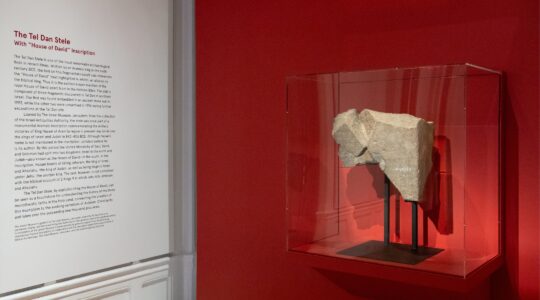Candlelighting, Readings:
Shabbat candles: 4:43 p.m.
Torah: Exodus 13:17-17:16
Haftorah: Judges 4:4-5:31 (Ashkenaz); 5:1-31 (Sephard)
Havdalah: 5:41 p.m.
The core of B’Shalach is Shirat Ha-Yam (The Song of the Sea): “Then Moses sang this song,” recounting the victories of the God of Israel over “all the deities of Egypt.” But the central question about Shirat Ha-Yam is an extension of a more general question that we ought be asking when learning Chumash: Why is a particular text placed where it is? What is the function of the text?
Shirat Ha-Yam is one of the truly majestic examples of biblical poetry. So in the first instance we need to ask: What is the function of biblical poetry? Then, what function does this song serve in our parasha?
Rabbi David Silber teaches that the function of any shirah (biblical song or poem) is to serve as a marker, to set off that section from those that precede and follow it.
In order to get a handle on this principle — and on Shirat Ha-Yam — we go far afield to another classic example of biblical poetry, Shirat Ha-Be’er (The Song of the Well) in Numbers. This little song, all of two verses long, is a puzzler: “Then Israel sang this song: Spring up, O well — sing to it. The well that the chieftains dug, which the nobles of the people started, with lawgivers — with their own staffs. “
What is the song all about, and why is it placed where it is?
The narrative preceding The Song of the Well is about wandering, minor skirmishes (most of which the Israelites lose), and water shortages. Immediately following Shirat Ha-Be’er is the defeat of Sichon and his Canaanite tribe, one of the most important stories in the Tanach. We are now at the beginning of the conquest of the Land of Israel. Shirat Ha-Be’er comes at this transitional moment, the song marking what precedes it and what is to follow.
Compare now, The Song of the Sea, perhaps the greatest piece of shirah (song) in the Tanach. Shirat Ha-Yam is a transitional text, as well, serving as a marker, separating the Exodus from the desert travel narratives culminating in the building of the Mishkan (Tabernacle).
The lead-in verses of each song are identical: “Az yashir . . .” “then (or thus) sang…” But in all other respects, the two songs are opposites. The Song of the Sea is all about Moses (“Then sang Moses…”), and more important, about God, His vanquishing the pagan gods of Egypt, how He caused the rulers of the world to quake with fear. Who is missing in The Song of the Sea? The people.
The Song of the Well tells a different story, with no mention of God or Moses. “Az yashir Yisrael” (“Then sang Israel!”). It’s all about m’chokek, leaders; n’divim, nobles; sarim, princes. The song is all about themselves, the Israelites. It’s a second-generation story: Miriam dies, Aaron dies, Moses will soon die; the leaders are gone. The second generation — no longer the slave generation — can and does capture the land. “Then sang Israel!” The caution suggested by the song is one of under-dependency; it’s all about us!
The Song of the Sea sends a different message. There is nothing about the people, retaining the insecurity of slavery, who still wonder about returning to Egypt. The song tells us about their reliance on God and Moses. This generation of the Exodus will not be permitted to enter the Land, but long after, by the time of BaMidbar (the Book of Numbers), the Israelites are a nation of princes — the sarim of The Song of the Well.
The synthesis comes in the third great shirah, Shirat Devorah (The Song of Deborah) in the Book of Judges, our haftarah. Shirat Devorah is also a marker, coming at the end of the conquest, indeed the final conquest in the Book of Judges — Eretz Yisrael (the Land of Israel). David Silber suggests that The Song of Deborah is where it all comes together: the role of God in the conquest and the role of the people — hamitnadvim ba’am — those who stepped up to the plate.
Support the New York Jewish Week
Our nonprofit newsroom depends on readers like you. Make a donation now to support independent Jewish journalism in New York.
It is no accident that The Song of Deborah is the haftarah for B’Shalach. It is not that it is a stunning work of biblical poetry, beautifully complementing The Song of the Sea. The point is that Shirat Devorah suggests that B’Shalach prefigures the final conquest of the Land, a process that began with the Exodus, merely hinted at in The Song of the Well. B’Shalach, the turning point of Exodus, takes us back to the bleak beginning [Exodus 2] — no names, no identity — and looks toward the promising end of the book: the building of the Mishkan, God’s house, the community of Israel, and ultimately, via the haftarah, to the full flowering of nationhood.
Jerome Chanes, a frequent contributor, is senior fellow at the Center for Jewish Studies, CUNY Graduate Center. He is the author of four books on Jewish public affairs and history.
The New York Jewish Week brings you the stories behind the headlines, keeping you connected to Jewish life in New York. Help sustain the reporting you trust by donating today.




